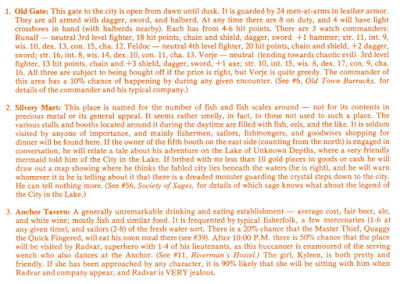The editor is listed as E. Gary Gygax, the assistant editor as Brian Blume, co-authors of "Warriors of Mars" (released the prior year, for which an advertisement is included).
TSR News:
We learn that TSR has acquired the rights from Guidon Games to publish Chainmail, and that a 3rd edition is to be published (the additional spells in Chainmail 3e were therefore likely drawn from OD&D, not vice versa).
Two companion booklets to Chainmail were mentioned as forthcoming, one dealing with the Crusades, and the other with mythical English Medieval times. Neither were ultimately released, although would have been interesting to see.
Creature Feature: The Mind Flayer
The dreaded Mind Flayer, as portrayed in the Blackmoor supplement (1975). Illustration by Tracy Lesch.
The mind flayer was introduced, a creature inspired by the cover illustration for "The Burrowers Beneath" by Brian Lumley according to Gary Gygax, in response to a Q & A thread in 2005. These brain-devouring creatures quickly became classic D&D villains.
A hit by one of their tentacles penetrates the skull within 1-4 combat "turns" (rounds) at which time their victim is killed (no saving throw) although I've adjudicated that a tentacle can be severed, if sufficient damage is inflicted (see entry for octopi, in the AD&D 1e Monster Manual).
Mind flayers as introduced in SR #1 also possess a raw form of psionics, the "mind blast", a 60' x 50' radius cone of "psi force" with effects determined by the intelligence score of the victim(s) ranging from death to permanent insanity.
Finally, the entry for mind flayers also lists an early example of "magical resistance" (at 90%). The only prior creatures with magical resistance were balrogs, (as discussed here), removed from later printings of the OD&D rules.
Wargaming World:
Old school dwarf with sword, one of the "Fantastiques" line of Der Kriegspielers miniatures.
We learn that the Hinchliffe line of Martian figures was released in the summer of 1974, the Tolkien-inspired "Fantastiques" line of Der Kriegspielers was being produced, and about a "Conan" series being prepared by MiniFigs.
Fanzines Europa, Great Plains Game Players Newsletter, and Wargamer's Digest, are mentioned, each of which published articles by Gygax (Europa #6-8 (Apr 1975), Great Plains Game Players Newsletter #7 (Apr 1975), Wargamer's Digest vol. 1 no. 7 (May 1974), vol. 2 no. 8, (Jun 1975).
Postal D&D Variant:
A postal D&Ds variant is advertised, combining D&D and Midgard, through the magazine Fantasia, as discussed in this post on the Blog of Holding in 2010.
Update (June 17, 2020): Jon Peterson discusses "Dungeons & Dragons at a Distance: Early Play-By-Mail D&D" on his blog, in May, 2020
Castle & Crusade:
A column for discussing the Chainmail rules, the first installment concerns "The Spear in Man-to-Man Combat" differentiating between the javelin, spear, lance, and pike.
Solo Dungeon Adventures:
The feature article for The Strategic Review #1 involves rules for solo dungeoneering, by Gary Gygax, with a special thanks to George A. Lord.* Preliminary testing was attributed to Robert Kuntz and Ernest Gygax.
*Jon Peterson discusses "The Invention of Randomly Generated Dungeons" on his blog, in November, 2017
The general architectural features, along with some of the tricks/traps, the gas subtable, and the properties of magic pools, are contemporaneous with the original Greyhawk Castle and El Raja Key dungeons.
A few omissions are noted:
Table I. is missing a line for "11-13" although should presumably read "Turn (see Table IV.)"
Table VI. is missing a line for "12" although should presumably read "Chimney down 1 level, passage continues, check again in 30'
Table VII. is missing a line for "19" but, as with "17-18", could also indicate a gas trap.
This article was later revised and expanded as the basis for Appendix A: Random Dungeon Generation in the AD&D 1e Dungeon Masters Guide.
Solo gaming by means of "Wilderness Adventures" is also mentioned, in apparent reference to general adventures using the "Outdoor Survival" playing board, as described in OD&D vol. 3: The Underworld and Wilderness Adventures.





















